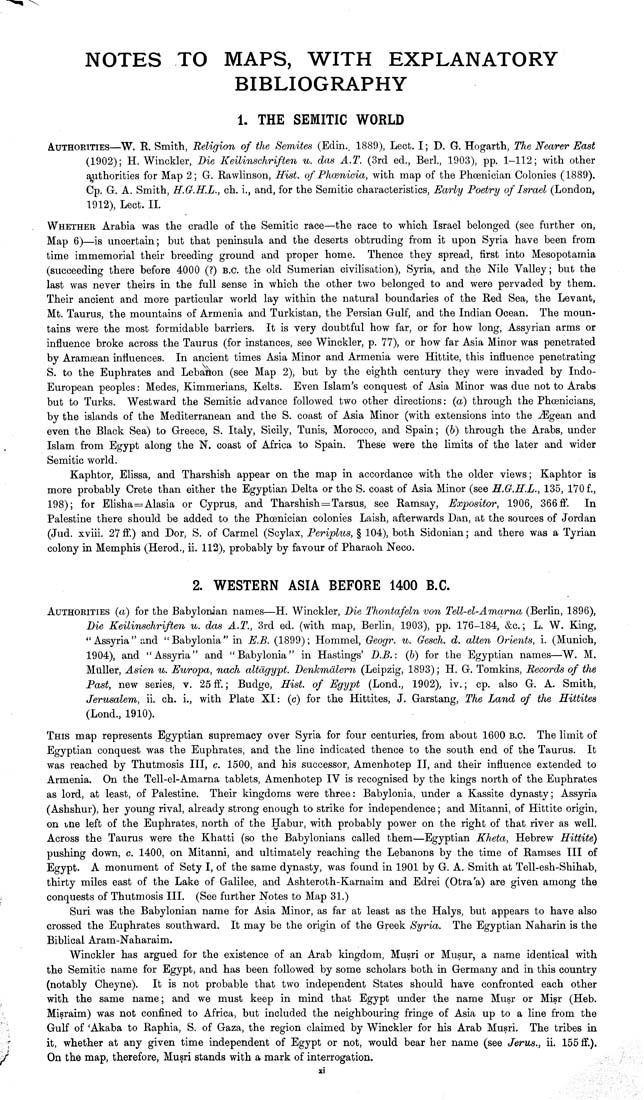NOTES TO MAPS, WITH EXPLANATORY
BIBLIOGRAPHY
1. THE SEMITIC WORLD
Authorities—W. R. Smith, Religion of the Semites (Edin.^ 1889), Lect. I; D. G. Hogarth, The Nearer East
(1902); H. Winckler, Die Keilinschriften u. das A.T. (3rd ed., Berl., 1903), pp. 1-112; with other
ajithorities for Map 2; G. Rawlinson, Hist, of Phoenicia, with map of the Phcenician Colonies (1889).
Cp. G. A. Smith, H.G.H.L., ch. i., and, for the Semitic characteristics, Early Poetry of Israel (London,
1912), Lect. IL
Whether Arabia was the cradle of the Semitic race—the race to which Israel belonged (see further on,
Map 6)—is uncertain; but that peninsula and the deserts obtruding from it upon Syria have been from
time immemorial their breeding ground and proper home. Thence they spread, first into Mesopotamia
(succeeding there before 4000 (?) B.C. the old Sumerian civilisation), Syria, and the Nile Valley; but the
last was never theirs in the full sense in which the other two belonged to and were pervaded by them.
Their ancient and more particular world lay within the natural boundaries of the Red Sea, the Levant,
Mt. Taurus, the mountains of Armenia and Turkistan, the Persian Gulf, and the Indian Ocean. The moun¬
tains were the most formidable barriers. It is very doubtful how far, or for how long, Assyrian arms or
influence broke across the Taurus (for instances, see Winckler, p. 77), or how far Asia Minor was penetrated
by Aramaean influences. In ancient times Asia Minor and Armenia were Hittite, this influence penetrating
S. to the Euphrates and Lebanon (see Map 2), but by the eighth century they were invaded by Indo-
European peoples: Modes, Kimmerians, Kelts. Even Islam's conquest of Asia Minor was due not to Arabs
but to Turks. Westward the Semitic advance followed two other directions: (a) through the Phoenicians,
by the islands of the Mediterranean and the S. coast of Asia Minor (with extensions into the ^gean and
even the Black Sea) to Greece, S. Italy, Sicily, Tunis, Morocco, and Spain; (h) through the Arabs, under
Islam from Egypt along the N. coast of Africa to Spain. These were the limits of the later and wider
Semitic world.
Kaphtor, Elissa, and Tharshish appear on the map in accordance with the older views; Kaphtor is
more probably Crete than either the Egyptian Delta or the S. coast of Asia Minor (see H.G.H.L., 135, 170 f.,
198); for Ehsha=:Alasia or Cyprus, and Tharshish=Tarsus, see Ramsay, Expositor, 1906, 366 ff. In
Palestine there should be added to the Phoenician colonies Laish, afterwards Dan, at the sources of Jordan
(Jud. xviii. 27 ff.) and Dor, S. of Carmel (Scylax, Periplus, § 104), both Sidonian; and there was a Tyrian
colony in Memphis (Herod., ii. 112), probably by favour of Pharaoh Neco.
2. WESTERN ASIA BEFORE 1400 B.C.
Authorities (a) for the Babylonian names—H. Winckler, Die Thontafeln von Tell-el-Amarna (Berlin, 1896),
Die Keilinschriften u. das A.T., 3rd ed. (with map, Berlin, 1903), pp. 176-184, &c.; L. W. King,
*'Assyria''and "Babylonia" in E.B. (1899); Hommel, Geogr. u. Gesch. d. alien Orients, i. (Munich,
1904), and "Assyria" and "Babylonia" in Hastings' D.B.: (b) for the Egyptian names—W. M.
Mtiller, Asien u. Europa, nach altdgypt. Denhmdlern (Leipzig, 1893); H. G. Tomkins, Records of the
Past, new series, v. 25 ff.; Budge, Hist, of Egypt (Lond., 1902), iv.; cp. also G. A. Smith,
Jerusalem, ii. ch. i., with Plate XI: (c) for the Hittites, J. Garstang, The Land of the Hittites
(Lond., 1910).
This map represents Egyptian supremacy over Syria for four centuries, from about 1600 B.C. The limit of
Egyptian conquest was the Euphrates, and the line indicated thence to the south end of the Taurus. It
was reached by Thutmosis III, c. 1500, and his successor, Amenhotep II, and their influence extended to
Armenia. On the Tell-el-Amarna tablets, Amenhotep IV is recognised by the kings north of the Euphrates
as lord, at least, of Palestine. Their kingdoms were three: Babylonia, under a Kassite dynasty; Assyria
(Ashshur), her young rival, already strong enough to strike for independence; and Mitanni, of Hittite origin,
on i;ne left of the Euphrates, north of the Habur, with probably power on the right of that river as well.
Across the Taurus were the Khatti (so the Babylonians called them—Egyptian Kheta, Hebrew Hittite)
pushing down, c. 1400, on Mitanni, and ultimately reaching the Lebanons by the time of Ramses III of
Egypt. A monument of Sety I, of the same dynasty, was found in 1901 by G. A. Smith at Tell-esh-Shihab,
thirty miles east of the Lake of Galilee, and Ashteroth-Karnaim and Edrei (Otra'a) are given among the
conquests of Thutmosis III. (See further Notes to Map 31.)
Suri was the Babylonian name for Asia Minor, as far at least as the Halys, but appears to have also
crossed the Euphrates southward. It may be the origin of the Greek Syria. The Egyptian Naharin is the
Biblical Aram-Naharaim.
Winckler has argued for the existence of an Arab kingdom, Musri or Musur, a name identical with
the Semitic name for Egypt, and has been followed by some scholars both in Germany and in this country
(notably Cheyne). It is not probable that two independent States should have confronted each other
with the same name; and we must keep in mind that Egypt under the name Musr or Misr (Heb.
Misraim) was not confined to Africa, but included the neighbouring fringe of Asia up to a line from the
Gulf of 'Akaba to Raphia, S. of Gaza, the region claimed by Winckler for his Arab Musri. The tribes in
it, whether at any given time independent of Egypt or not, would bear her name (see Jerus., ii. 155 ff.).
On the map, therefore, Musri stands with a mark of interrogation.
|








